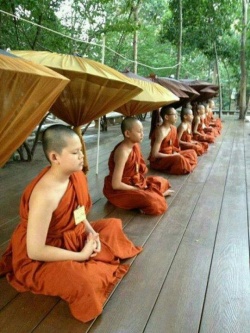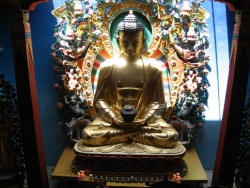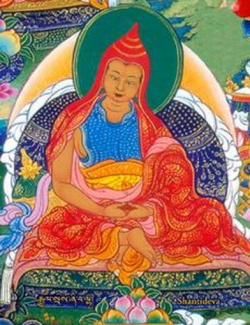Green
Green is a color, the perception of which is evoked by light having a spectrum dominated by energy with a wavelength of roughly 520-570-nm. In the subtractive color system, it is not a primary color, but is created out of a mixture of yellow and blue, or yellow and cyan; it is considered one of the additive primary colors. On the HSV color wheel, the complement of green is magenta; that is, a purple color corresponding to an equal mixture of red and blue light. On a color wheel based on traditional color theory (RYB), the complementary color to green is considered to be red.
The word green is closely related to the Old English verb growan, 'to grow'. It is used to describe plants or the ocean. Sometimes it can also describe someone who is inexperienced, jealous, or sick. In America, green is a slang term for money, among other things. Several colloquialisms have derived from these meanings, such as 'green around the gills', a phrase used to describe a person who looks ill.
Several minerals have a green color, including the emerald, which is colored green by its chromium content. Animals such as frogs, lizards, and other reptiles and amphibians, fish, insects, and birds, appear green because of a mixture of layers of blue and green coloring on their skin. By far the largest contributor to green in nature is chlorophyll, the chemical by which plants photosynthesize. Many creatures have adapted to their green environments by taking on a green hue themselves as camouflage.
Culturally, green has broad and sometimes contradictory meanings. In some cultures, green symbolizes hope and growth, while in others, it is associated with death, sickness, envy or the devil.
The most common associations, however, are found in its ties to nature. For example, Islam venerates the color, as it expects paradise to be full of lush greenery. Green is also associated with regeneration, fertility and rebirth for its connections to nature. Recent political groups have taken on the color as symbol of environmental protection and social justice, and consider themselves part of the Green movement, some naming themselves Green parties. This has led to similar campaigns in advertising, as companies have sold green, or environmentally friendly, products.
The word green comes from the Old English word grene, or, in its older form, groeni. This adjective is closely related to the Old English verb growan (to grow) and goes back into Western Germanic and Scandinavian languages.
The word designates the color on the visible light spectrum situated between blue and yellow. It is often used to describe foliage and the sea, and has become a symbol of environmentalism. It also is combined with other color names to increase specificity, as in blue-green, or with objects, as in emerald green. Green is also used to describe jealousy and envy, as well as anyone young, inexperienced, or gullible (probably by analogy to unripe, i.e. unready or immature, fruit).
Green is sometimes associated with nausea and sickness.
Lastly, green can communicate safety to proceed, as in traffic lights.
Overall, greens, along with blues and purples, are frequently described as cool colors, in contrast to red and yellow.
Some languages have no word separating green from blue.
The word green is found in several colloquial phrases derived from these meanings: in golf, the region of grass around the hole is trimmed short and referred to as the putting green, or simply, the green.
Someone who works well with plants is said to have a green thumb or green fingers, a physically-ill person is said to look green around the gills, and the word greenhorn refers to an inexperienced person.
A company is greenwashing if they advertise positive environmental practices to cover up environmental destruction.
Green with envy highlights another emotional association, which William Shakespeare had first described as the "green-eyed monster" in Othello and The Merchant of Venice.
In areas that use the U.S. Dollar as currency, green carries a connotation of money, wealth, and capitalism, because green is the color of United States banknotes, giving rise to the slang term greenback for cash.
Religion and Philosophy
The Libyan flag is completely green, in honor of Islam's veneration of the color.
Green is considered the traditional color of Islam, likewise because of its association with nature. This is for several reasons. First, Muhammad is reliably quoted in a hadith as saying that 'water, greenery, and a beautiful face' were three universally good things.
In the Qur'an, sura Al-Insan, believers in God in Paradise wear fine green silk.
Also, Al-Khidr (The Green One), is a Qur'anic figure who met and traveled with Moses. The flag of Hamas, as well as the flag of Iran, is green, symbolizing their Islamist ideology.
Roman Catholic and more traditional Protestant clergy wear green vestments at liturgical celebrations during Ordinary Time.
In the Eastern Catholic Church, green is the color of Pentecost.
Green is one of the Christmas colors as well, possibly dating back to pre-Christian times, when evergreens were worshipped for their ability to maintain their color through the winter season. Romans used green holly and evergreen as decorations for their winter solstice celebration called Saturnalia, which eventually evolved into a Christmas celebration.
The Wizard of Oz
One of the more notable uses of this meaning is found in The Wonderful Wizard of Oz. In this story is the Emerald City, where everyone wears tinted glasses which make everything look green. According to the populist interpretation of the story, the city's color is used by the author, L. Frank Baum, to illustrate the financial system of America in his day, as he lived in a time when America was debating the use of paper money versus gold.
Alice Bailey, in her system called the Seven Rays which classifies humans into seven different metaphysical psychological types, the "third ray" of "creative intelligence" is represented by the color green. People who have this metaphysical psychological type are said to be "on the Green Ray".
In Hinduism, Green is used to symbolically represent the fourth, heart chakra (Anahata).
Green Crystals
Psychics who claim to be able to observe the aura with their third eye report that someone with a green aura is typically someone who is in an occupation related to health, such as a physician or nurse, as well as people who are lovers of nature and the outdoors.
Green frequency is linked to healing and alchemy.
Color Symbolism Represented in Buddhist Traditions#Green



